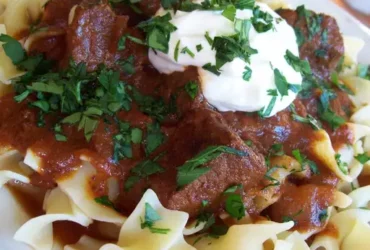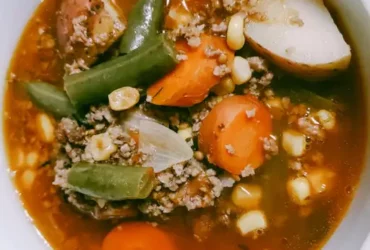Ingredients
Vegetables
The ingredients used in making a delicious fresh tomato soup recipe are numerous and varied. For the purpose of this discussion, we will focus on the vegetables that play a crucial role in enhancing the flavor and texture of the soup.
Tomatoes are undoubtedly the star of the show when it comes to fresh tomato soup. There are several types of tomatoes that can be used depending on personal preference and availability. Some popular options include beefsteak, cherry, Roma, and heirloom varieties. Fresh tomatoes should be chosen based on their ripeness, with slightly soft skin indicating they are ready for use.
Onions add a sweet and savory flavor to the soup. Yellow or white onions can be used, but red onions provide an additional layer of depth due to their sweeter taste. It’s essential to caramelize the onions before adding them to the soup, as this process breaks down their cellular structure and releases their natural sugars.
Garlic is another fundamental ingredient in many soups, including fresh tomato soup. Like onions, garlic has a strong flavor that benefits from being caramelized before being added to the pot. Three or four cloves are typically sufficient for a standard recipe.
Bell peppers bring a burst of color and sweetness to the dish. Green bell peppers can be used, but red or yellow varieties add a pop of color and a slightly sweeter flavor. They should be diced and cooked until tender before being added to the soup.
Herbs such as basil and oregano can add a fresh and earthy flavor to the soup. A sprig of fresh basil leaves can be used, while dried or fresh oregano is also acceptable. These herbs enhance the overall flavor profile without overpowering the other ingredients.
Celery adds a crunchy texture and a subtle sweetness that complements the tomatoes. The celery stalk should be diced and cooked until tender before being added to the pot.
Fresh tomatoes (2 cups), onion (1 medium), garlic (3 cloves)
The foundation of a great Fresh Tomato Soup recipe lies in the quality and freshness of its core ingredients, particularly the tomatoes. In this case, we’ll be using two cups of fresh tomatoes, preferably harvested at their peak ripeness for optimal flavor. The natural sweetness and acidity of these juicy gems will add depth to our soup.
Next in line is the onion, a crucial component in many soups, including ours. A single medium-sized onion will suffice to provide that savory base note we’re looking for. It’s essential to chop it finely so its flavor can blend harmoniously with the other ingredients.
And then there’s the garlic, often a misunderstood ingredient. While many believe three cloves might be too much, it’s precisely this amount that will imbue our soup with its signature warmth and aroma. When minced, the flavors of these three cloves will infuse every spoonful.
The balance between sweetness and savoriness is essential in a Fresh Tomato Soup recipe like this. By combining the fresh tomatoes, onion, and garlic with some aromatic herbs, we can create a deliciously rich soup that’s both comforting and invigorating.
Aromatics
The ingredients required for making a delicious and fresh tomato soup recipe include:
Main Ingredients
- Tomatoes – 3-4 lbs, depending on their size and your desired consistency
- Onion – 1 medium-sized, thinly sliced
- Garlic – 2-3 cloves, minced
- Celery – 2 stalks, diced
- Basil leaves – a handful of fresh leaves or 1 tsp dried basil
- Olive oil – for sautéing the aromatics
Aromatics
- These are ingredients that add flavor and aroma to the soup.
- Salt – to taste, helps bring out the flavors of other ingredients
- Black pepper – freshly ground, adds a nice kick to the soup
- Red pepper flakes – optional, for some heat (if you like spicy food)
Pureed tomatoes
- If you don’t have fresh tomatoes or prefer not to chop them up, you can use 2 cups of canned crushed or diced tomatoes.
Other ingredients
- You may also want to add some cream or coconut milk for added richness and creaminess (optional)
- Some people also like to add a pinch of sugar to balance out the acidity from the tomatoes
Bay leaves (2), thyme (1 sprig)
When it comes to selecting ingredients for a delicious and authentic fresh tomato soup, two essential items that deserve consideration are bay leaves and thyme.
Bay leaves, with their distinctive mellow flavor, play a crucial role in enhancing the overall taste experience of the soup. Typically used in pairs, which is why we’re using 2 bay leaves, they add depth to the broth without overpowering it.
Thyme, on the other hand, brings an aromatic and slightly savory element that complements the sweetness of the tomatoes perfectly. We’re only using a single sprig because thyme can be quite potent; too much would overbalance the flavor profile of our soup.
The delicate balance of flavors in this fresh tomato soup recipe relies heavily on the subtle contributions from these herbs, making them an integral part of its success.
Liquids
The ingredients required for a classic fresh tomato soup recipe include:
- Tomatoes: The star of the show, you will need approximately 3 pounds (1.36 kg) of fresh, ripe tomatoes. You can use any variety of tomato that suits your taste, but it is recommended to opt for a mix of red and green tomatoes for added flavor.
- Olive Oil: A small amount of high-quality olive oil will be used for sautéing the onions and garlic, adding an aromatic flavor to the soup. About 2-3 tablespoons (30-45 ml) is sufficient.
- <bonions:< b=””> Chopped yellow or white onions add a sweet depth of flavor and texture to the soup. Use about 1 large onion, chopped finely.</bonions:<>
- Garlic: Mince 3-4 cloves of fresh garlic to release their aromatic flavors during sautéing.
- Potatoes: Diced potatoes add body and creaminess to the soup. Use about 1 medium-sized potato, peeled and diced.
- Broth: You will need approximately 2 cups (475 ml) of vegetable or chicken broth to help create a rich, savory flavor.
- Herbs: Chopped fresh herbs like basil, oregano, and thyme add freshness and aroma. Use about 1/4 cup (15 g) of chopped fresh herbs.
The liquids used in the recipe include:
- Water: Used to sauté the onions, garlic, and tomatoes.
- Olive Oil: Added for flavor during sautéing.
- Broth: Provides a rich, savory flavor to the soup.
Please note that you can adjust the amount of broth according to your preference and desired consistency.
Chicken or vegetable broth (4 cups)
When it comes to making a delicious and flavorful fresh tomato soup, one of the most essential ingredients is chicken or vegetable broth. This liquid base adds depth and richness to the soup, allowing the natural sweetness of the tomatoes to shine through.
The amount of broth required can vary depending on personal preference for the consistency of the soup. For this recipe, we will be using 4 cups of broth, which provides a good balance between the flavors of the tomatoes and the creamy texture from other ingredients.
There are several options when it comes to choosing a broth for your fresh tomato soup: chicken or vegetable. Both types can enhance the flavor of the soup, but they have distinct characteristics:
- Chicken broth is a clear favorite among many cooks due to its ability to add a savory and slightly sweet taste to dishes.
- Vegetable broth, on the other hand, offers a lighter and more delicate flavor profile, making it an excellent choice for those looking to avoid meat products or prefer a vegetarian option.
In general, vegetable broth works best when using fresh tomatoes as they are naturally sweet. This balance complements the slightly bitter taste of some vegetables found in the broth, creating a harmonious flavor experience.
When selecting a store-bought chicken or vegetable broth, consider the following factors:
- Look for low-sodium options to prevent an overly salty soup.
- Certifications like ‘Organic’ or ‘USDA Choice’ can indicate higher quality and safety standards.
To incorporate the broth into your recipe, simply heat it up in a pot before adding other ingredients. This step allows for even distribution of flavors throughout the soup.
Seasonings
- The foundation of any great soup starts with fresh ingredients, and for this tomato soup recipe, you’ll want to focus on using high-quality tomatoes as the base.
- You can use a combination of different types of tomatoes, such as heirloom, cherry, or grape tomatoes, to achieve the desired flavor and texture.
- For a classic tomato soup flavor, look for tomatoes that are heavy for their size, have a deep red color, and are slightly soft to the touch.
- Other essential ingredients include onions, garlic, carrots, celery, and herbs like basil and thyme.
- These aromatics will add depth and complexity to your soup, while also providing a subtle sweetness that complements the tomatoes.
- In terms of seasonings, you’ll want to use a combination of salt, black pepper, and other spices to bring out the natural flavors of the ingredients.
- A pinch of red pepper flakes adds a touch of heat without overpowering the dish, while a sprinkle of dried oregano enhances the herbal notes in the soup.
- Don’t forget to use freshly ground black pepper, as it makes a big difference in the flavor profile of your soup.
- Aromatic spices like cumin and paprika can also be used to add warmth and depth to the soup, but use them sparingly, as they can quickly overpower the dish.
- For a creamier soup, consider adding some heavy cream or half-and-half towards the end of cooking time, as this will help to balance out the acidity from the tomatoes.
Salt, black pepper
The foundation of any exceptional recipe lies in its ingredients, and for our Fresh Tomato Soup Recipe, we have carefully selected a few key components that will elevate this dish to new heights.
Salt is an essential seasoning that plays a crucial role in bringing out the natural flavors of the tomatoes. It enhances their sweetness, adds depth, and balances out any acidity.
Black pepper, on the other hand, is often used as a secondary seasoning to complement salt. Its slightly bitter and earthy flavor works perfectly with the brightness of the tomatoes, creating a harmonious balance that will tantalize your taste buds.
In our recipe, we use a generous amount of salt to allow the flavors of the tomatoes to shine through. This is particularly important since we’re using fresh, uncooked tomatoes that haven’t had their natural sweetness and acidity reduced by heat or cooking.
Black pepper adds a subtle yet distinctive kick that complements the creaminess of the soup without overpowering it. Its aroma also enhances the overall bouquet of the dish, making each spoonful an invigorating experience for your senses.
When using salt and black pepper in our Fresh Tomato Soup Recipe, we recommend seasoning them liberally but tastefully, allowing the natural flavors of the tomatoes to take center stage. You can always adjust the amount to your liking, but remember that a little goes a long way – especially with salt.
The perfect ratio for our recipe is about 3-4 parts salt to 2 parts black pepper. However, feel free to experiment and find the balance that works best for you and your taste buds.
Tips and Variations
Purée for a Creamy Texture
Puréeing the soup to achieve a creamy texture is a crucial step in making a delicious fresh tomato soup. One way to ensure that your soup has a smooth and velvety consistency is to use an immersion blender or a regular blender to purée the ingredients until they are fully broken down.
Blending the soup with some heavy cream or hazelnut milk can add richness and depth of flavor, while also enhancing the creamy texture. However, for those who want a lighter and more refreshing take on tomato soup, blending in some Greek yogurt or cottage cheese can be an excellent alternative.
An additional tip is to roast the tomatoes before puréeing them, as this brings out their natural sweetness and adds a deeper flavor profile. This can be done by cutting the tomatoes in half and placing them on a baking sheet lined with parchment paper, drizzling with olive oil and seasoning with salt and pepper before roasting at 375°F (190°C) for about 20-25 minutes.
Another variation is to add some aromatic spices such as cumin, coriander, or smoked paprika to give the soup an extra boost of flavor. Additionally, adding a splash of white wine vinegar can help balance out the sweetness of the tomatoes and add a tangy taste.
Some other ingredients that can be added to enhance the creamy texture of the soup are cashew cream, coconut milk, or even ricotta cheese. Experimenting with different combinations of these ingredients can lead to unique and delicious variations of fresh tomato soup.
Blend cooked soup in blender or with an immersion blender for a smooth consistency
To achieve the perfect consistency in your fresh tomato soup, consider the following tips and variations:
Blending Techniques
- For a silky smooth soup, blend cooked tomatoes with an immersion blender or a regular blender.
- Blend hot soup in small batches to prevent overheating the blender or food processor. You can also let it cool slightly if blending is more comfortable at that time.
- Hold back some of the vegetables, such as onions and carrots, and blend them separately before adding them to the main mixture for an extra layer of texture and flavor.
Texture Options
- Roughly chopped tomatoes add a chunky texture while preserving much of their fresh flavor, ideal for those who prefer heartier soups.
- A coarse puree still has some chunks but is smoother than the first option. This works well if you’re aiming for a rustic soup with character.
- A silky smooth consistency removes all visible particles, creating a refined and elegant dish perfect for those who prefer their soups ultra-smooth.
Temperature Adjustments
- To prevent scalding when blending hot soup, consider tempering it by adding a small amount of cold broth or water first. This helps to stabilize the temperature and blend smoothly.
- For an even colder soup, you can add some ice cubes to chill it down before serving. Just be cautious not to add too much ice, which may dilute the flavors.
Add-ins for Customization
- Try adding a dollop of cream or yogurt for an extra touch of richness and a cooler contrast to balance out the warmth of the soup.
- Crispy bacon bits, chopped fresh herbs like parsley or basil, or croutons add interesting textures that can complement or contrast with the smoothness of the soup.
Add Some Zing
To take your fresh tomato soup to the next level, consider adding some zing with these tips and variations:
- Add a pinch of red pepper flakes or diced jalapeños for an extra kick of heat.
- Use roasted garlic instead of raw garlic for a deeper, nuttier flavor.
- Swirl in some high-quality olive oil or truffle oil to add a luxurious touch and aromatic flavor.
- Try using different types of tomatoes, such as cherry tomatoes, grape tomatoes, or heirloom tomatoes, for varying levels of sweetness and texture.
- Add some acidity with a squeeze of fresh lemon juice or a splash of vinegar, like balsamic or apple cider vinegar.
- Sauté onions, shallots, or leeks before adding the garlic and tomatoes for added depth of flavor.
- Use vegetable broth or stock instead of water to add more body and richness to the soup.
- Add some fresh herbs, such as basil, oregano, or parsley, towards the end of cooking time to preserve their delicate flavors.
- Experiment with different spices and seasonings, like smoked paprika, ground cumin, or dried thyme, to give the soup a unique flavor profile.
- Make it a creamy soup by blending in some heavy cream, Greek yogurt, or coconut milk.
- Use this recipe as a base and add your favorite protein sources, such as grilled chicken, sautéed shrimp, or roasted vegetables, for added nutrition and variety.
Use lemon juice or red wine vinegar to add brightness and depth of flavor
To add an extra layer of brightness and depth to your fresh tomato soup, consider incorporating a splash of acidity through lemon juice or red wine vinegar. This will help cut through the richness of the tomatoes and create a more well-rounded flavor profile.
When using lemon juice, start with a small amount (about 1-2 tablespoons per quart of soup) and adjust to taste. You can add it towards the end of cooking time, as its acidity may break down the delicate flavors of the tomatoes if added too early.
For red wine vinegar, use a similar ratio (1-2 tablespoons per quart of soup). However, be aware that vinegar is more pungent than lemon juice, so you may want to start with an even smaller amount and taste as you go. The acidity will help balance the natural sweetness of the tomatoes.
Consider combining lemon juice or red wine vinegar with other ingredients for added depth. For example, adding a pinch of salt can enhance the flavors, while a sprinkle of fresh basil adds a bright, herbal note. Experiment with different combinations to find your perfect balance of flavors.
In terms of variation, try using different types of tomatoes, such as cherry or grape tomatoes, which will add a sweeter and more concentrated flavor profile. You can also experiment with roasting the tomatoes before pureeing them for added depth and caramelized sweetness.
Another option is to use canned crushed tomatoes instead of fresh, which can be easier to work with and provide a similar consistency to cooked-down tomatoes. Just be aware that canned tomatoes may have added salt or preservatives, so adjust your seasoning accordingly.
If you’re looking for a creamier soup, try adding a splash of heavy cream, Greek yogurt, or coconut milk towards the end of cooking time. This will add a rich and velvety texture without overpowering the other flavors.
Step-by-Step Instructions
Mise en Place
Mise en place refers to the French culinary term that describes the process of preparing and organizing all the ingredients and tools needed for a dish before starting to cook. In the context of the fresh tomato soup recipe, mise en place involves setting up a workstation with all the necessary components to ensure smooth and efficient cooking.
The first step in implementing mise en place for the fresh tomato soup recipe is to wash and chop the tomatoes. This involves carefully selecting and washing a sufficient number of tomatoes, depending on their size and your desired amount of soup. The tomatoes should be chopped into small pieces, either diced or pureed, depending on the texture you prefer.
Next, prepare the aromatics by peeling and chopping onions, garlic, and any other vegetables called for in the recipe. For example, celery can be chopped to add depth to the soup, while carrots can be added for an extra burst of color and flavor.
Mise en place also involves measuring out all the spices and seasonings required for the recipe, including salt, black pepper, dried herbs like basil or oregano, and any other desired flavors. This ensures that you have everything ready to go when it’s time to cook the soup.
In addition to preparing the ingredients, mise en place involves setting up a workstation with all the necessary tools and equipment. This may include pots, pans, utensils like spoons and spatulas, colanders for straining the soup, and other essentials needed throughout the cooking process.
Finally, mise en place requires you to organize your ingredients in a logical order, often on a kitchen counter or prep station, so that you can easily access them as needed. This helps maintain workflow and prevents unnecessary delays during cooking.
By following this step-by-step approach to mise en place, you’ll be well-prepared to execute the fresh tomato soup recipe with ease and confidence. The organized setup will also enable you to efficiently navigate through each stage of cooking and achieve a perfectly balanced flavor in your finished dish.
Prepare all ingredients before starting the recipe
When preparing a fresh tomato soup recipe, it’s essential to follow step-by-step instructions to ensure that every component turns out perfectly. The first crucial step involves gathering and preparing all the ingredients before starting the cooking process.
The initial preparation phase includes washing and chopping the tomatoes. Select three pounds of ripe, red tomatoes for this recipe, as they will add a burst of juicy sweetness to the final soup product.
After cleaning the tomatoes thoroughly under running water, place them on a clean cutting board and chop each one into quarters or even halves if needed. This process makes it easier to release their natural juices during cooking.
Next, peel two medium-sized onions by removing their outer layers and slice them thinly. The onions will add a depth of flavor and aroma that complements the tomatoes beautifully.
Closely related to onions in terms of aromatic properties are three cloves of garlic. Peel off their papery skin, chop into smaller pieces if necessary, or leave them intact for added texture and potency during cooking.
Mince one teaspoon of dried basil, an herb that will tie the entire dish together with its distinct, yet subtle flavor profile. Mix it well with salt (about half a teaspoon) to create a balanced seasoning blend.
In addition to the ingredients mentioned so far, you’ll also need two cups of chicken broth and heavy cream or half-and-half for an extra-rich texture. These components serve as the base liquid of your fresh tomato soup and provide necessary moisture without overpowering the natural flavors.
Lastly, prepare a tablespoon of unsalted butter for sautéing the onions and garlic at the start of the recipe. This addition will enrich their flavor and create an ideal foundation for the rest of the dish.
Now that all ingredients are prepared, it’s time to begin the cooking process, but first, ensure each component is organized in a way that makes sense for your workflow.
Sauté Aromatics
To sauté aromatics for a Fresh Tomato Soup Recipe, follow these step-by-step instructions:
Step 1: Gather Ingredients and Equipment
Gather the following ingredients:
- 2 tablespoons butter
- 1 medium onion, chopped (about 2 cups)
- 3 cloves garlic, minced
- 2 stalks celery, chopped (about 1 cup)
Prepare your equipment:
- A large saucepan with a heavy bottom (stainless steel or enameled cast iron) for sautéing and simmering
Step 2: Chop the Aromatics
- Chop the onion into medium-sized pieces, about 1 inch (2.5 cm) in size. You can use a chef’s knife or a food processor with the chopping attachment.
- Mince the garlic cloves using a press or a microplane grater.
- Chop the celery stalks into medium-sized pieces, similar to the onion.
Step 3: Sauté the Aromatics
- Melt 1 tablespoon of butter in the saucepan over medium heat. You can also use a combination of butter and oil, like olive or avocado oil.
- Add the chopped onion to the saucepan and sauté for about 5 minutes, stirring occasionally, until it becomes translucent and starts to caramelize.
- Add the minced garlic and stir well. Cook for another minute, until fragrant.
- Finally, add the chopped celery stalks to the saucepan and continue sautéing for about 3-4 minutes, until they are tender and slightly caramelized.
Step 4: Season and Combine
- Add a pinch of salt to bring out the flavors and seasonings.
- If using, add any additional aromatics like thyme or bay leaves to enhance the flavor profile.
- Combine all the sautéed ingredients in a large bowl or directly into the saucepan for further processing.
Step 5: Proceed with Tomato Soup Recipe
- Add the remaining ingredients, such as diced tomatoes and vegetable broth, to the bowl or saucepan.
- Puree the mixture using an immersion blender or a regular blender for a smooth consistency.
- Simmer the soup over low heat for at least 20-25 minutes, until the flavors have melded together and the soup has thickened slightly.
Now you have sautéed aromatics ready to be incorporated into your Fresh Tomato Soup Recipe!
Cook onion, garlic, and thyme in olive oil until softened
To make this delicious Fresh Tomato Soup, we’ll start by cooking the aromatics, which will add depth and flavor to our soup.
First, let’s prepare the ingredients. We’ll need:
- 1 medium onion
- 3 cloves of garlic
- A sprig of fresh thyme
- 2 tablespoons of Olive Oil
To cook the aromatics, follow these steps:
- Cut the onion into small, uniform pieces.
- Mince the garlic cloves and set them aside.
- Strip the leaves off of the thyme sprig and chop them finely.
- Heat the Olive Oil in a large saucepan over medium heat.
- Add the chopped onion to the saucepan and cook until it is softened and translucent, stirring occasionally.
- Add the minced garlic cloves to the saucepan and cook for another minute, stirring constantly to prevent burning.
- Add the chopped thyme sprig to the saucepan and cook for an additional 30 seconds, until fragrant.
Once the aromatics are cooked, we can proceed with the rest of the recipe. Stay tuned!
Simmer Soup
To simmer soup to perfection, it’s essential to follow a series of steps that will ensure your fresh tomato soup turns out flavorful and smooth.
Step 1: Chop the Vegetables
Cut one large onion into small pieces, making sure not to leave any large chunks behind. You can also chop up three cloves of garlic and set them aside for later use.
Mince two medium-sized carrots, taking care not to make them too fine or they might break down during cooking.
Step 2: Sauté the Aromatics
In a large pot, heat two tablespoons of olive oil over medium heat. Once hot, add the chopped onion and sauté until it’s translucent and starts to caramelize, stirring occasionally.
Add the minced garlic and cook for another minute, stirring constantly to prevent burning.
Step 3: Add the Vegetables
Add the chopped carrots and any other desired vegetables (such as diced bell peppers or celery) to the pot. Cook until they start to soften, about five minutes, stirring occasionally.
Step 4: Add the Canned Tomatoes
Add two cups of canned crushed tomatoes, one cup of chicken or vegetable broth, and one teaspoon of dried basil to the pot.
Cook for another five minutes, allowing the flavors to meld together and the vegetables to become tender.
Step 5: Simmer the Soup
- Reduce heat to low and let the soup simmer for at least 20-25 minutes, or until it reaches your desired consistency.
- Puree the soup using an immersion blender or transfer it to a blender in batches and blend until smooth.
- Add salt and pepper to taste, adjusting the seasoning as needed.
- Simmer the soup for another 5-10 minutes to allow the flavors to meld together and the soup to heat through evenly.
Serve and Enjoy!
Ladle the soup into bowls and serve hot, garnished with a sprinkle of chopped fresh herbs or a dollop of sour cream, if desired.
Add remaining ingredients to pot and cook over low heat for 2030 minutes
- To complete the fresh tomato soup recipe, add all the remaining ingredients to the pot.
- This includes any diced onions, minced garlic, chopped fresh herbs such as basil or parsley, and grated cheese if desired.
- Next, place the pot over low heat on your stovetop.
- The low heat setting is essential for preventing the soup from burning or developing an unpleasant flavor.
- Cook the ingredients for 20 to 30 minutes, stirring occasionally, until they are fully incorporated and heated through.
- Best Datanyze Alternatives for 2025 - April 24, 2025
- Best Hunter.io Alternatives for 2025 - April 22, 2025
- Best Lead411 Alternatives for 2025 - April 22, 2025















